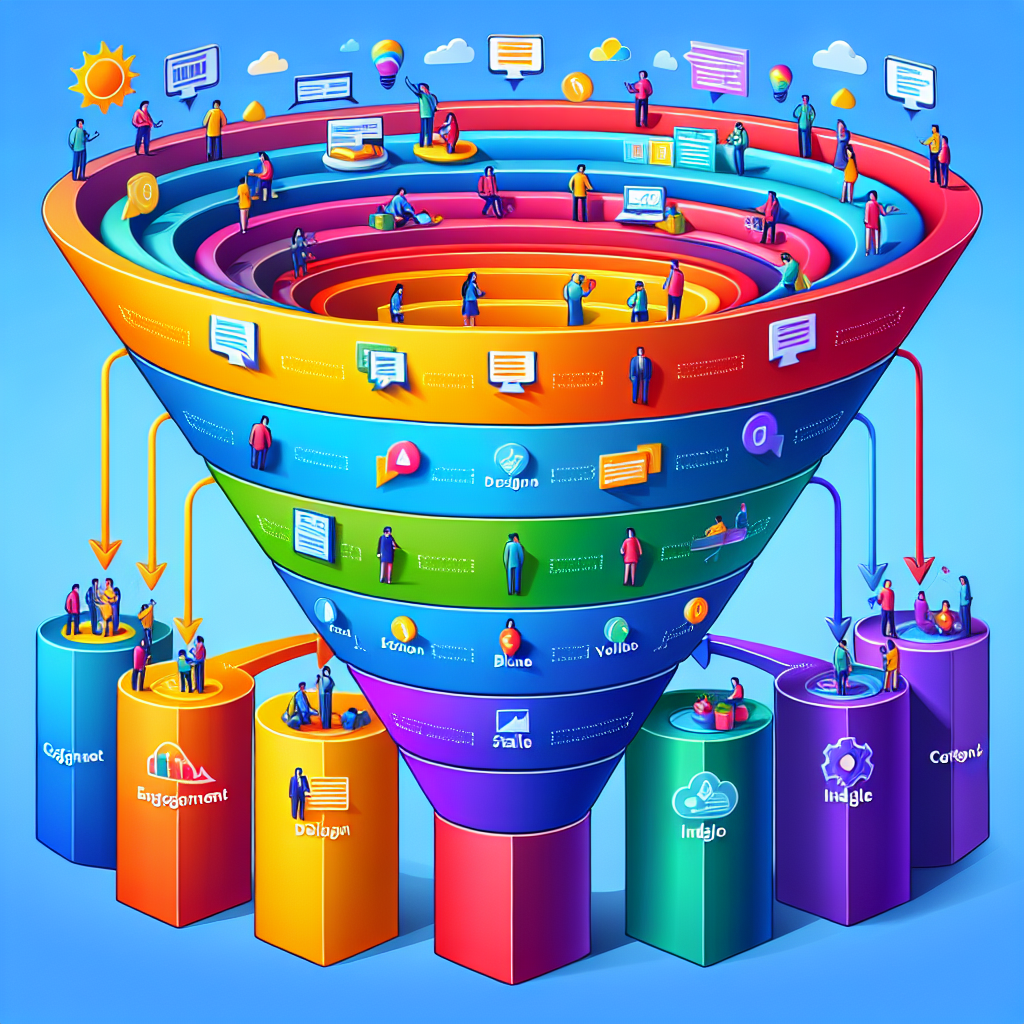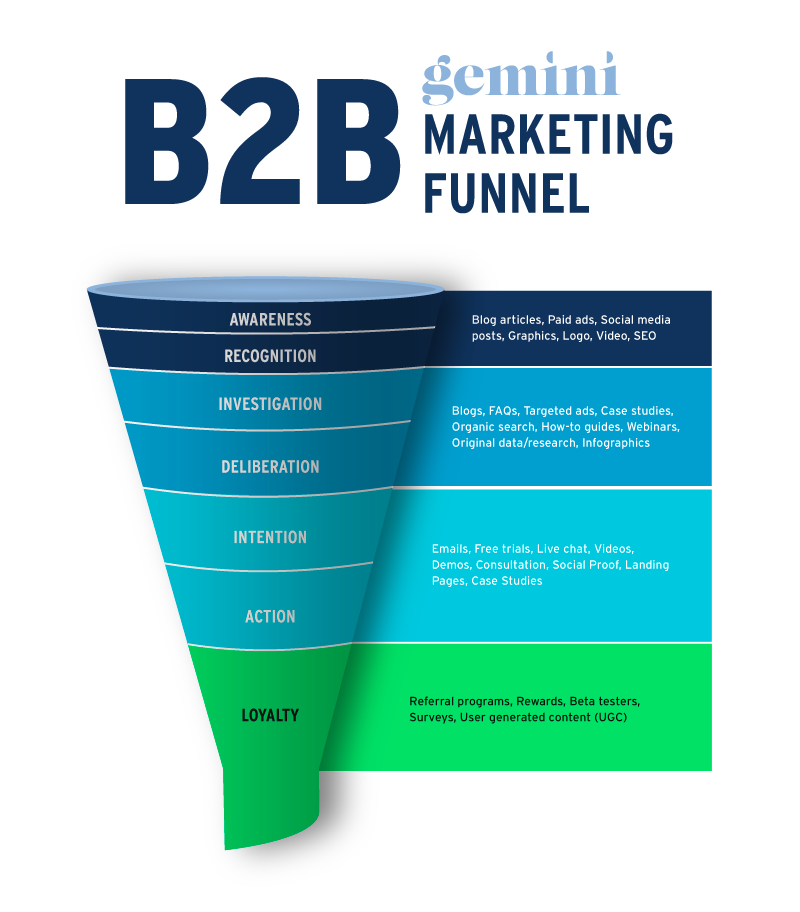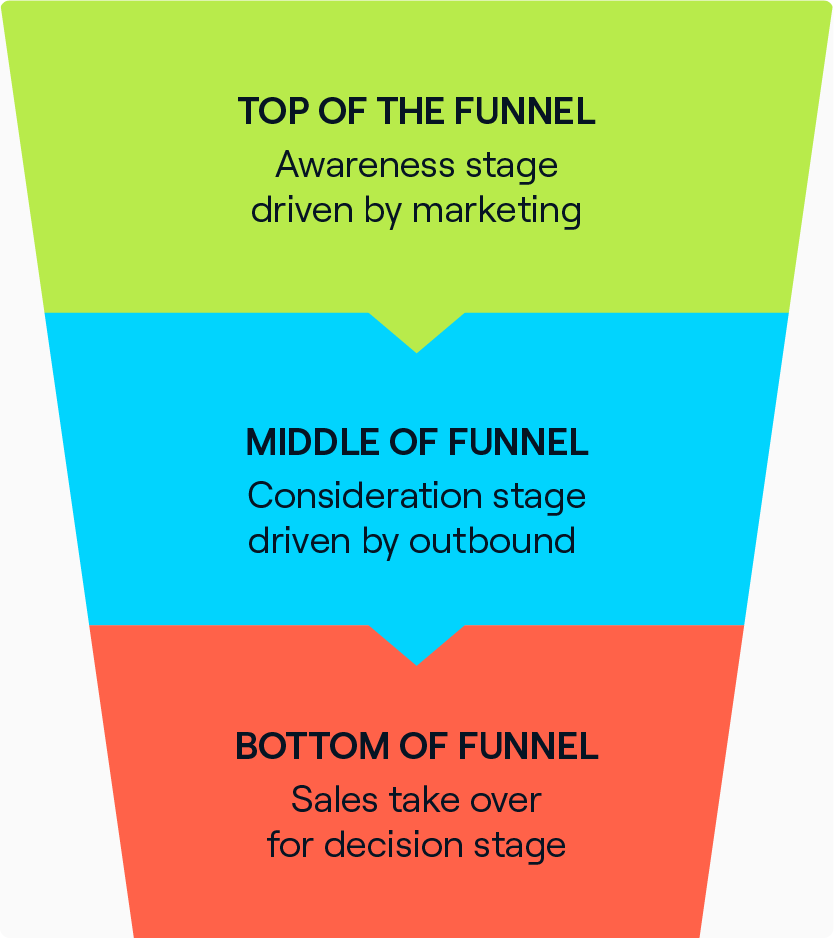From top-of-funnel awareness to bottom-of-funnel conversion, uncover the secrets to successfully navigate the B2B content marketing funnel stages.

Image courtesy of via DALL-E 3
Table of Contents
Introduction to B2B Content Marketing Funnel
Welcome to the world of B2B content marketing! In this digital landscape, businesses are constantly vying for the attention of other businesses to showcase their products or services. This is where the B2B content marketing funnel comes into play. Let’s take a dive into understanding what this funnel is all about and how it can help businesses like yours attract and retain valuable clients.
What is a B2B Content Marketing Funnel?
Imagine a funnel as a tool that guides potential customers from knowing nothing about your business to becoming loyal clients. The B2B content marketing funnel works in a similar way. It takes prospects through a journey of awareness, interest, consideration, decision, and retention. Each stage aims to nurture leads and ultimately convert them into satisfied customers.
Why is it Important?
Understanding and utilizing the B2B content marketing funnel is crucial for businesses selling products or services to other businesses. By strategically creating and distributing content tailored to each stage of the funnel, you can effectively engage with your target audience, build trust, and drive conversions. This structured approach helps businesses build lasting relationships with clients and ultimately grow their bottom line.
The Awareness Stage
In the Awareness Stage of the B2B Content Marketing Funnel, we focus on the top of the funnel where potential clients first become aware of your business. This stage is crucial as it is where you start to grab the attention of your target audience and introduce them to your brand.
Creating Engaging Content
Creating engaging content is key at the Awareness Stage. This includes informative blog posts, attention-grabbing videos, and interactive social media content. The goal is to create content that piques the interest of potential clients and prompts them to learn more about your business.
Channels to Use
When it comes to spreading awareness, choosing the right channels is essential. Platforms like LinkedIn, Twitter, and industry-specific blogs are effective tools for reaching your target audience. By strategically utilizing these platforms, you can maximize your reach and get your content in front of the right eyes.
Tips for Maximizing Reach
To maximize your reach during the Awareness Stage, consider tactics like optimizing your content for search engines, collaborating with influencers in your industry, and engaging with your audience through comments and shares. By implementing these tips, you can increase the visibility of your content and attract more potential clients to your business.
The Interest Stage
Once potential clients have shown interest in your business, it’s crucial to keep them engaged. One effective way to do this is through lead nurturing. This involves providing valuable information to potential clients through channels like newsletters, case studies, and webinars. By keeping in touch with leads and offering them relevant content, you can continue to build a relationship and move them closer to making a purchasing decision.

Image courtesy of geminiams.com via Google Images
Building Trust
Trust is a fundamental aspect of any successful business relationship. In the interest stage of the B2B content marketing funnel, it’s essential to focus on developing trust with potential clients. This can be achieved through educational and valuable content that addresses their pain points and provides solutions. By consistently offering valuable content and demonstrating your expertise in your field, you can show potential clients that you are a reliable and trustworthy partner.
Using Interactive Content
Interactive content is a great way to engage your audience and keep them interested in what your business has to offer. By incorporating elements like polls, quizzes, and surveys into your content strategy, you can encourage participation and make the content more engaging. Interactive content not only helps capture the attention of potential clients but also provides valuable insights into their preferences and interests, allowing you to tailor your offerings to better suit their needs.
The Consideration Stage
In the consideration stage of the B2B content marketing funnel, potential clients are carefully evaluating their options and weighing the benefits of your solutions. This is a crucial part of the decision-making process where your content can make a significant impact on their choice.
Offering Detailed Information
One of the best ways to support potential clients in this stage is by providing them with in-depth and comprehensive content. Resources like whitepapers, eBooks, and detailed guides can help them understand the intricacies of your offerings and how they can address their specific needs.
Customer Testimonials
Customer testimonials and case studies are powerful tools in the consideration stage. Hearing about the positive experiences of other businesses who have used your products or services can provide reassurance and build trust with decision-makers. These real-life stories can sway the opinions of potential clients and influence their decision in your favor.
Building a Strong Case
To stand out among competitors, it’s essential to build a strong case for why your product or service is the best choice. Present compelling arguments, detailed propositions, and clear benefits to showcase the value you can offer. By articulating your unique selling points and addressing potential concerns, you can help prospects see why choosing your business is the right decision.
The Decision Stage
At the decision stage of the B2B content marketing funnel, prospects are ready to make a purchasing decision. One effective strategy to help them finalize this decision is by offering product demos or free trials. These hands-on experiences allow potential clients to get a feel for your product or service and understand how it can meet their needs. By offering demos or trials, you provide a low-risk opportunity for prospects to see the value you can deliver.

Image courtesy of www.cognism.com via Google Images
Special Offers and Discounts
Another tool in your arsenal at the decision stage is the use of special offers and discounts. These can act as a closing strategy to encourage prospects to take the final step towards conversion. By providing exclusive deals or limited-time discounts, you create a sense of urgency and incentivize potential clients to make a purchase. These special offers can tip the scales in your favor and help seal the deal.
FAQs and Support
During the decision stage, it’s crucial to address any lingering questions or concerns that prospects may have. This is where frequently asked questions (FAQs) and comprehensive support come into play. By proactively answering common queries and providing reliable support, you can instill confidence in potential clients and help them make an informed decision. Accessibility to information and assistance can make a significant difference in converting prospects into loyal customers.
The Retention Stage
In the retention stage, it’s essential to keep your clients happy and engaged after they’ve made a purchase. One way to do this is by creating follow-up content, such as thank-you emails, onboarding materials, and tutorials. These materials show your clients that you value their business and are committed to helping them make the most out of their purchase.
Building Loyalty Programs
To encourage repeat business and foster customer loyalty, consider implementing loyalty programs. These programs reward customers for their continued support and can include perks like exclusive discounts, early access to new products, or special events. By making customers feel appreciated, you can increase their loyalty and likelihood of coming back for more.
Content for Continuous Engagement
Regularly engaging with your customers is crucial for maintaining a strong relationship and encouraging repeat business. Create content that provides value and keeps your audience informed and engaged, such as newsletters, product updates, and webinars. By staying in touch with your customers, you can continue to nurture the relationship even after the sale is made.
How to Measure Success
In order to determine how well your B2B content marketing strategies are performing, you need to measure success using specific tools and metrics. By identifying key metrics, utilizing analytics tools, and adjusting your strategies based on data, you can ensure the effectiveness of each stage in the content marketing funnel.

Image courtesy of growthrocks.com via Google Images
Identifying Key Metrics
One crucial aspect of measuring success in B2B content marketing is identifying key metrics that indicate performance. These metrics include website traffic, engagement rates, conversion rates, and lead generation. By monitoring these metrics, you can gauge how well your content is resonating with your target audience and driving business goals.
Using Analytics Tools
Analytics tools such as Google Analytics and CRM software are essential for tracking the performance of your content marketing efforts. These tools provide valuable insights into audience behavior, content engagement, and conversion rates. By leveraging these tools, you can gather data to analyze and optimize your strategies for better results.
Adjusting Strategies
Once you have gathered and analyzed data from your key metrics, it’s crucial to adjust your content marketing strategies accordingly. By identifying what’s working and what’s not, you can make informed decisions on how to improve your content, target the right audience, and drive better results. Continuous optimization based on data insights is key to long-term success in B2B content marketing.
Common Mistakes to Avoid
One common mistake businesses make in B2B content marketing is neglecting audience research. Knowing your audience is crucial for crafting content that resonates with them. When this step is overlooked, companies risk creating content that misses the mark and fails to engage potential clients. To avoid this pitfall, take the time to understand your target audience’s needs, pain points, and preferences. Conduct surveys, analyze data, and gather feedback to ensure your content strategy aligns with your audience’s interests.
Ignoring SEO Best Practices
Another mistake to avoid is ignoring SEO best practices. Search engine optimization plays a vital role in improving your content’s visibility and driving organic traffic to your website. By neglecting SEO, businesses miss out on valuable opportunities to attract leads and increase conversions. To prevent this error, focus on optimizing your content for relevant keywords, improving site speed, and building quality backlinks. By incorporating SEO best practices into your content strategy, you can enhance your online presence and reach a wider audience.
Inconsistent Messaging
Consistency in messaging and branding is essential for building trust and credibility with your audience. When businesses fail to maintain a cohesive brand voice across all channels and touchpoints, they risk confusing and alienating potential clients. Inconsistencies in messaging can create a disjointed experience for customers, leading them to question the authenticity of your brand. To steer clear of this mistake, establish brand guidelines and standards for communication. Ensure that all content aligns with your brand’s values, tone, and personality to convey a unified message to your audience.
Conclusion – Navigating the Journey
As we reach the end of this guide on navigating the B2B content marketing journey, it’s essential to reflect on the key strategies and insights discussed throughout. Understanding the intricacies of the B2B content marketing funnel is vital for businesses looking to attract, engage, and retain clients effectively.

Image courtesy of dotit.org via Google Images
Recap of Key Strategies
Throughout this journey, we’ve explored the importance of creating engaging content at every stage of the funnel. From the awareness stage where potential clients first discover your business to the decision stage where they are ready to make a purchasing choice, each phase requires unique approaches and tailored content to guide them along the path.
We’ve discussed the significance of nurturing leads, building trust, offering valuable information, and utilizing interactive content to keep your audience engaged and interested in what your business has to offer. Additionally, we’ve highlighted the importance of post-purchase strategies to retain clients and foster customer loyalty.
The Path Ahead
Looking ahead, implementing the strategies outlined in this guide can lay the foundation for long-term success in your B2B content marketing efforts. By consistently measuring and analyzing key metrics, adjusting strategies based on data-driven insights, and avoiding common pitfalls, businesses can optimize their content marketing funnel for better results.
Remember, success in B2B content marketing is not immediate, but rather a gradual process that requires patience, persistence, and a strategic approach. By focusing on delivering valuable content, understanding your audience’s needs, and nurturing leads throughout the funnel, you can position your business for sustained growth and client retention.
Want to turn these SEO insights into real results? Seorocket is an all-in-one AI SEO solution that uses the power of AI to analyze your competition and craft high-ranking content.
Seorocket offers a suite of powerful tools, including a Keyword Researcher to find the most profitable keywords, an AI Writer to generate unique and Google-friendly content, and an Automatic Publisher to schedule and publish your content directly to your website. Plus, you’ll get real-time performance tracking so you can see exactly what’s working and make adjustments as needed.
Stop just reading about SEO – take action with Seorocket and skyrocket your search rankings today. Sign up for a free trial and see the difference Seorocket can make for your website!
Frequently Asked Questions (FAQs)
What is the B2B Content Marketing Funnel?
The B2B Content Marketing Funnel is a strategic approach that guides potential customers through the journey from initially discovering your business to eventually becoming loyal clients. It involves different stages where you use specific content and tactics to nurture leads and drive conversions.
How Long Does it Take to See Results?
The timeline for seeing results from your content marketing efforts can vary depending on several factors, such as the industry you’re in, the quality of your content, and how effectively you implement your strategies. In general, it may take a few months to start seeing significant results, but consistency and patience are key.
What are Some Effective Content Types?
At the awareness stage of the B2B Content Marketing Funnel, engaging content like blog posts, videos, and social media content works best to attract potential clients. As you move through the funnel, other effective content types include case studies, whitepapers, webinars, and interactive elements like polls and quizzes to keep your audience engaged and interested in what you have to offer.







